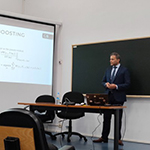Splitting a dataset is a common practice in machine learning to avoid overfitting the model to the
training data and to evaluate the models generalization performance on unseen data. Typically, a
random split is made with a fixed ratio (e.g., 80% for training and 20% for testing) or a predefined
number of folds (k) for cross-validation.
...
The most common type of splitter is the train-test splitter, which divides the dataset into two
subsets: the training set and the test set. The training set is used to train the machine learning
model, while the test set is used to evaluate the performance of the trained model. Typically, the
training set is
...
In traditional machine learning approaches, separate models are trained for each task, which can be
computationally expensive and lead to overfitting due to the limited amount of data available for
each task.
...
Unlike model parameters, hyperparameters are not learned during the training process but rather are
set by the machine learning engineer or data scientist. Hyperparameters control the
...
This process typically includes several steps, which may vary depending on the specific task and the
nature of the data:
**Text Preprocessing**: This step involves cleaning the text data to remove any unwanted characters,
symbols, or numbers. This can include tasks like removing punctuation, converting all
...
